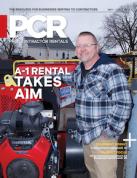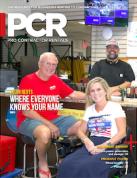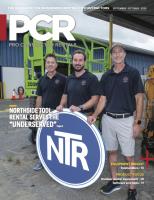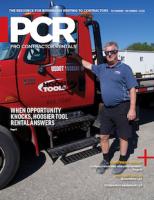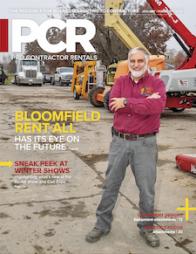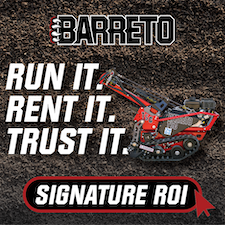Field Report -- Remote-controlled mainstream machines: The future is now
Doosan Bobcat unveils a proprietary remote-control system for new R Series skid-steer and track loaders...and more.
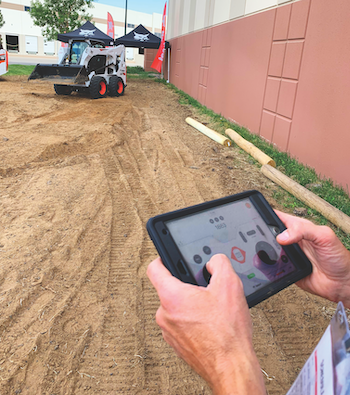 |
| Bobcat MaxControl remote operation provides convenient, easily accessible remote-control operation using an app on an iPhone, iPad or joystick. |
The definite star of the show at the Bobcat press media presentation at its new Denver-based training facility in mid-September was the new technology that takes machine operation to a totally new level.
Most revolutionary is the Bobcat’s MaxControl remote-control platform that literally removes the operator from the cab. Further, the Bobcat Machine IQ wireless communications/Bobcat owner portal takes the world of telematics to a totally new level by introducing a game-changing way to activate machine features to better match customer needs. The system also allows setting up geofences to prevent equipment from traveling into unwanted areas.
Subscription system
The iPhone/iPad-based app allows, through a subscription-based system, for dealers and their technicians to dial in performance characteristics the end user wants. For rental operations, an owner could set the operating parameters to match the job, then set the rate based on the machine’s capabilities, not its size or standard options.
“Remote operation is coming. Our customers are already using emerging digital products and services and that shapes what they expect from Bobcat,” says Joel Honeyman, vice president of Global Innovation at Doosan Bobcat. “This is disruption and it’s happening fast,” he continues, “Our objective is, ‘How can we be the disruptor?’”
He reports that macro trends are shaping the world. “It’s happening on three fronts: social, technological and the increasing availability of low-cost battery power sources.”
From a social standpoint, he cites 5G wireless connectivity will open the world to having information access on a multitude of smart equipment, tools and services.
“Today’s 4G cellular service can support 1,000 devices per square mile. That’s why cellular service at stadiums and other large venues can be so slow. With 5G, that capacity is one million devices per square mile. That will affect the social sharing of data.
“Further, services such as Uber are conditioning users to pay for services, not things. It’s affecting how users are looking at equipment, paying for its use only when they need it. Amazon is also conditioning customers that they can shop and get what they want the next day or even the very same day,” he says.
Finally, technological advances in electricity and battery power will continue, bringing lower-cost sources of energy that have much more power to an even wider array of tools and equipment.
Disruption on the equipment front
From a construction equipment standpoint, these disrupting macro trends are being exacerbated by three factors: Shortage of operators; customers consolidating operations; and equipment becoming more driven by smart technology or computing power, not brain power. “Construction equipment has pretty much done the same thing for the last 50 years, but we will now see construction equipment change dramatically in the not-too-distant future,” he says.
Equipment industry direction
“Where are we headed? We are slowly moving into the connection phase with equipment. We are moving from a selling environment to an engagement phase where users just want the use of equipment. That will eventually lead to autonomous equipment in five years or less,” Honeyman predicts, “Users will be using equipment available on a subscription or rental basis to get work done.”
To accomplish that, Bobcat experts are working so its equipment meets three strategies:
First, it must be simple and functional for the end user. Second, it must easily upgradeable and even backward compatible with equipment already in the field. Third, it must provide customer value, not be technology for technology’s sake. “It must solve job site problems,” Honeyman says.
Remote control specifics
In this first rollout of remote control on its new R Series skid-steer and compact track loaders, the technology allows three levels of control that will be accessible at the dealer, owner and user levels with permissions catered to the needs of the owner and machine. “It’s a subscription-based model that will set up parameters based on the permission level of the person with access,” says John Pfaff, Bobcat senior electrical test development engineer.
Called Features On Demand, it allows customers to purchase an R-Series compact loader that has the capability to activate a set of features per the customers’ request at the time they purchase the machine. After purchase, customers then have the flexibility to adapt their equipment with preinstalled hardware as their needs change. Features that are included are high-flow auxiliary hydraulics, two-speed travel, reversing fan, dual-direction bucket positioning and automatic ride control.
Ultimately, sources report Features On Demand will offer customers a lower upfront cost, compared to buying a machine with features they won’t use right away, and lower expenses later to add these features to the machine.
“Features such as high- and low-level hydraulic flow, ride control, reversible-fan and bucket self-level control are options that must be built into machines at the factory; they can’t be easily added after the unit is built,” says Justin Odegaard, Bobcat acceleration manager. “With our proprietary control system, we can turn these features on or off in the field. In the future, dealers will be able to manage the horsepower output of the model. Many other capabilities are in development.”
From a rental standpoint, perhaps the upside is that a rental center could dial-in performance characteristics users want, set rates accordingly, and in turn streamline their fleets.
The technology also allows remote control of equipment, eliminating the need for an operator inside the unit. “This is the first step to develop truly autonomous machines,” says Honeyman.
The new system allows users to program geofences or virtual barriers that the machine can’t cross. “It could be used to protect areas where a landscaper doesn’t want to be disturbed or help a unit plowing snow avoid hidden obstacles,” says Pfaff.
The technology is now available through Doosan Bobcat and its dealers.
This article appeared in the November-December 2019 issue of Pro Contractor Rentals magazine. © 2019 Urbain Communications LLC. All rights reserved.



